This Brazilian Beach Destination Is a Quieter, Laid-back Alternative to Rio de Janeiro
Tucked away on Brazil’s remote Bahian coast, Trancoso is an unspoiled, bohemian beach getaway.
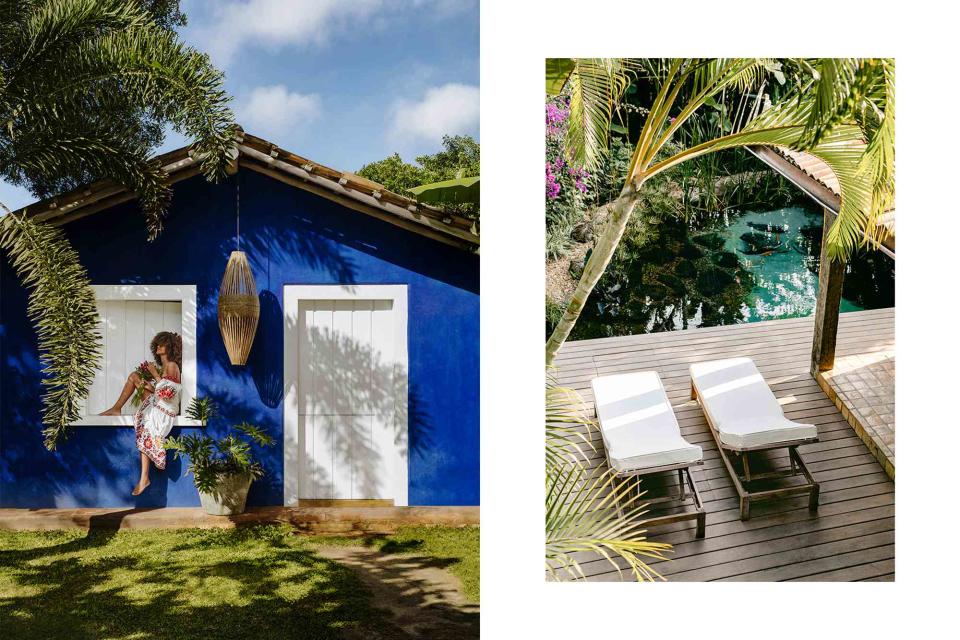
Marta Tucci
From left: Model Franciele Jesus dos Santos wears a Farm Rio dress at Uxua Casa Hotel & Spa, a boutique hotel in Trancoso, Brazil; Casa do Lago, one of the accommodations at Uxua Casa Hotel & Spa, overlooks a natural, swimmable lake.I was curled up on an oversize daybed at Uxua Praia, a beach club in Trancoso — the coastal Brazilian playground that first captured the imagination of the international creative set back in the 1980s. The club is an offshoot of Uxua Casa Hotel & Spa, a quietly upscale property near the Quadrado, as Trancoso’s historic town center is known, where my family and I were staying. Uxua Praia’s bar, which sits in the hull of a weathered fishing boat under a thatched roof, is tended by a young, cheerful staff, who take their time making cocktails from scratch, juicing fresh fruit for each order.
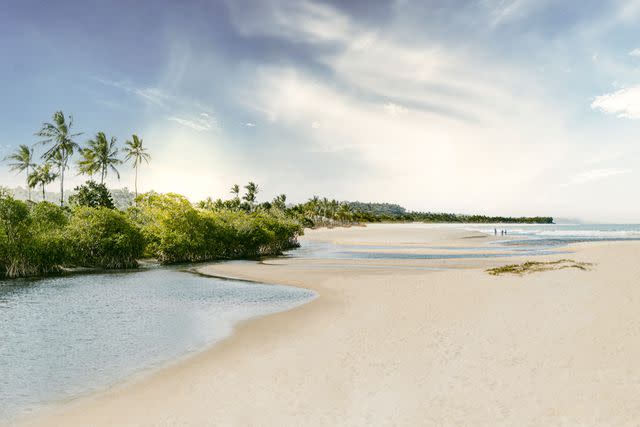
Marta Tucci
The Atlantic coast near Trancoso, Brazil.Though Trancoso is often thought of as a beach town — it shares the same breezy vibes found in places like Canggu, in Bali, or Mexico’s Isla Holbox — its Quadrado is set back from the sea. To reach the shore, and Uxua Praia, my husband, two teenage sons, and I first walked past a series of low-slung traditional stucco storefronts the color of Skittles. We navigated a thicket of ancient silver lime trees whose limbs — as gnarled as a grandmother’s — seem to defy the laws of gravity with their precarious reach. A few minutes later, at what felt like the end of the earth, we reached a gleaming-white 17th-century Catholic church, São João Batista, and, filling the horizon beyond, the ocean.
We wound our way down past the church, crossing a rickety wooden bridge and passing through one of the longest uninterrupted mangrove forests in Brazil. Once we reached Uxua Praia, the biggest decision of the day was whether to order the grilled shrimp and pineapple skewers or the lime and coconut milk ceviche. Why not both? The food seemed to appear as though by magic from a tiny kitchen hidden in the mangroves.
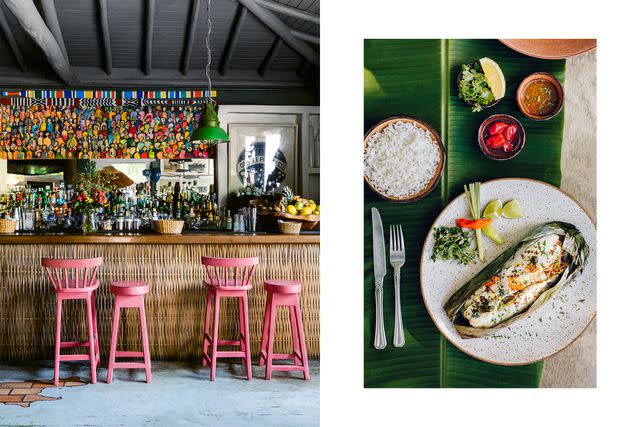
Marta Tucci
From left: The bar at the restaurant Jacaré do Brasil; fish wrapped in banana leaves at Capim Santo.As I waded back through shin-deep water after a dip, I saw a handful of vendors with rugs, basket bags, and cold drinks walking along the shore. A woman in a paisley cover-up strutted past as though she was simply carrying her wares across the beach rather than trying to hawk them. Like so many of the artists and craftspeople in the area, she looked just as glamorous in her oversize straw hat as many of the guests staying at Uxua.
Related: The Style Lover's Guide to Brazil
When I waved her over, she showed me a few strappy maxis and a short wrap dress with cap sleeves, the kind of global fast-fashion designs you see just about anywhere. Clocking my lack of enthusiasm, she dashed off, only to return a few minutes later with a few beautiful, hand-block-printed cotton dresses. “These are my designs,” she said in nearly accentless English. To my eye, they would have sat comfortably in a Manhattan boutique alongside pieces from designers like Isabel Marant and Ulla Johnson — though these were a fraction of the price. I bought one, and rather than pushing me to purchase a second, she walked away. It occurred to me that the “take it or leave it” vibe I got from her and the other vendors had to do with the fact that they, by and large, were the makers themselves. Which is to say, artisans first, salespeople second.
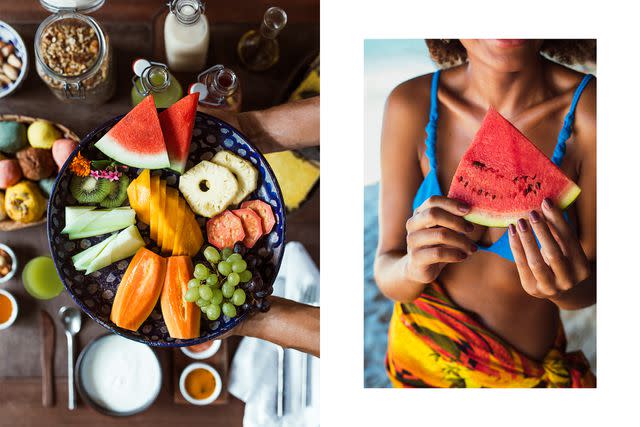
Marta Tucci
From left: Breakfast at Uxua includes fruit, yogurt, and homemade granola; local Sarita Santos snacks at the Uxua beach bar.Everything about Trancoso, which was once a sleepy fishing village, felt too good to be true, with just the right amount of bohemian cool mixed with the powerful presence of the natural world, in the form of the jungle that surrounds and weaves through town. How this place, which has a population of just over 10,000, has escaped the sort of overtourism that plagues other seaside destinations is a function of geographic isolation, government protection, and a bit of luck.
Related: Delta Is Making It Easier to Travel to South America With These New Routes
For centuries, Trancoso was inaccessible to anyone but its Indigenous population, and by the 1970s, only a handful of families remained as the younger generations left to find work. Even today, getting there is hard: I took a 10-hour flight from New York City to São Paulo, followed by a two-hour hop to Porto Seguro and, finally, a 90-minute drive.
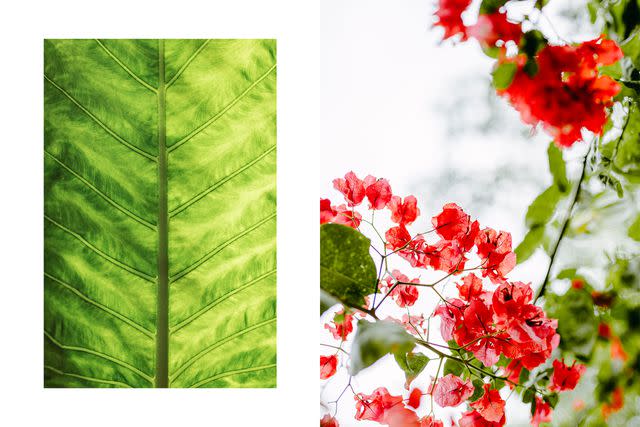
Marta Tucci
Local flora in Trancoso.Uxua’s debut brought more attention to the region. Its cofounder, Wilbert Das, is the Dutch-born former creative director of the Italian fashion label Diesel. He first visited Trancoso in 2004 and immediately fell in love with the area. On a subsequent visit, he convinced his friend and business partner Bob Shevlin to come along. They got to talking and, by 2009, had opened Uxua. Since then, Das has become something of an unofficial mayor in Trancoso. It’s not uncommon to see him greeting guests, toggling between English and Portuguese, while embracing the chic, creative types who always seem to be passing through.
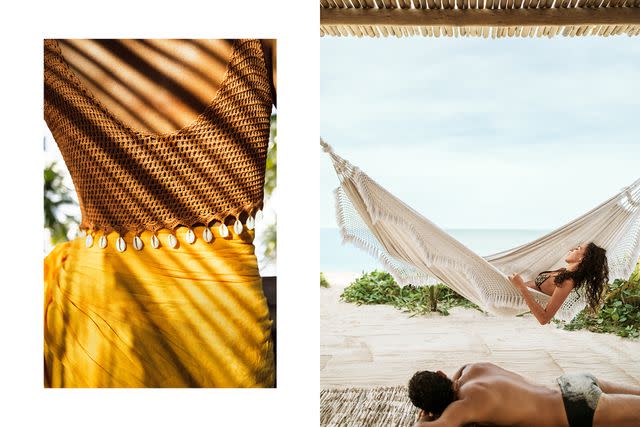
Marta Tucci
From left: Brazilian beachwear at Uxua beach club; siesta time on the beach in Trancoso.One night, I ran into Das myself, and he recounted the story of how Trancoso’s fortunes turned in the late 1970s. “First it was the hippies from Europe: Italy, Switzerland, France — and also from Argentina,” he said. And, as often happens in migrations like this, the hippies paved the way for the artists. By the late 80s, he went on, Trancoso was a go-to escape for Brazil’s creative elite — actors, musicians, singers, and artists. “They all came for the same reasons: the natural beauty and the freedom. They set the tone for a place that wasn’t about money and created an aesthetic and a lifestyle that attracted similar types of people.” Along with the free-love sensibility came a sense of responsibility, Das added. “People learned that preservation is a good thing. They knew they had something precious.”
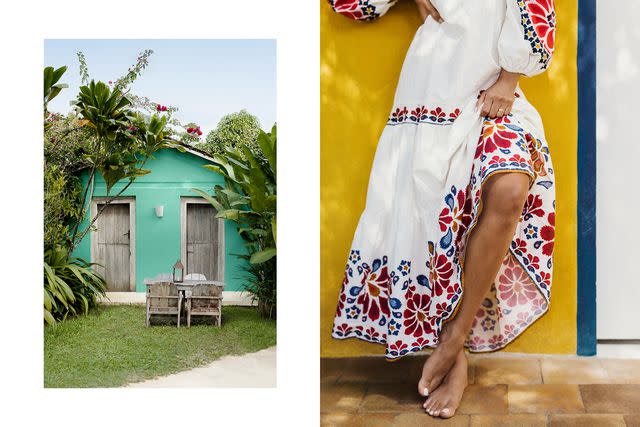
Marta Tucci
From left: Now part of Uxua Casa, Zé e Zilda was formerly a private home; Trancoso native Franciele Jesus dos Santos poses against one of Uxua Casa's colorful bungalows.When the sun finally set, the Quadrado, where the canopy of trees was hung with hundreds of lanterns, came to life as locals and visitors went out to eat, shop, and listen to music late into the night. At Uxua’s restaurant, we could have happily ordered moqueca — the traditional Bahian seafood stew — every night. Their version had a bright veggie-forward flavor and ingredients sourced from nearby growers — including those at the hotel’s own farm, Uxua Roça, not far outside town. After dinner each night, we strolled around the Quadrado. Cars were notably absent, as were any international chain stores.
More Trip Ideas: Travel + Leisure Readers' 10 Favorite Cities in Central and South America of 2023
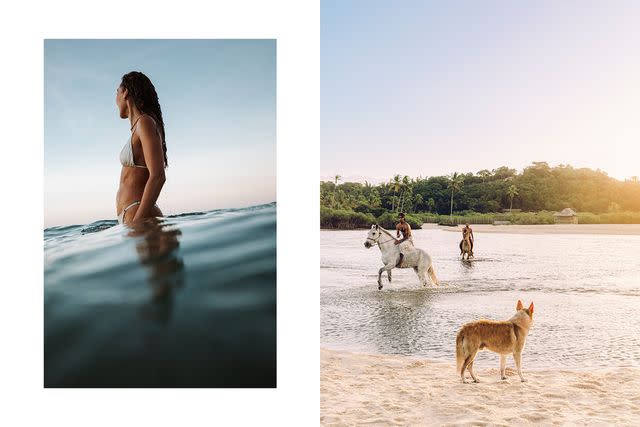
Marta Tucci
From left: Resident Nina Borges takes a sunset dip at Coqueiros Beach; crossing the Trancoso River on horseback.The 24-room Uxua Casa — a series of renovated centuries-old bungalows along the Quadrado — was once the only luxurious place to stay in town. That changed with the December 2021 opening of the Hotel Fasano Trancoso. (The stylish Brazilian hotel group is best known for its swanky properties in Rio de Janeiro and São Paulo.) Located on Itapororoca Beach, about a 10-minute drive from Uxua Casa, the resort was completed only after a four-year approval process: both the Brazilian Institute of Environment & Renewable Natural Resources and the National Historic & Artistic Heritage Institute, which strictly regulates new buildings, had to sign off.
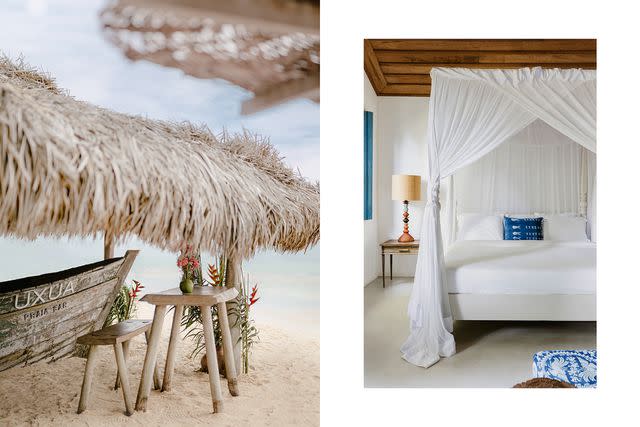
Marta Tucci
From left: Uxua Praia, on Coqueiros Beach; the Lakeside Suite at Casa do Lago.The Fasano broke with the area’s architectural conventions and built 40 modern, flat-roofed casitas across a sprawling 720-acre plot. Fasano was allowed to develop only a portion of the property, much of which is now a nature preserve, and all of the accommodations — plus two restaurants and a spa — are oceanfront.
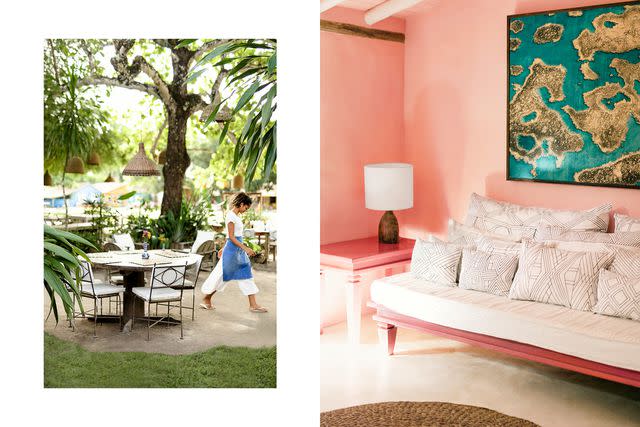
Marta Tucci
From left: Uxua Casa's restaurant is set under a canopy of trees; the spa at Uxua Casa, which integrates Indigenous healing practices and Brazilian products in its treatments.Despite its sleek aesthetic, Fasano wears its luxury lightly, and for someone who wants to spend more than a few days in the area, this is the more exclusive-feeling answer to Uxua’s hipster-village vibe. While all of the beaches in Brazil are, by law, public, the Fasano’s distance from town means hotel guests often have the shoreline to themselves. On the day we checked in, we didn’t leave the property; instead, we spent the morning swimming in the ocean, then had a lunch of grilled shrimp at the beachside restaurant. On our second day, a concierge arranged for a self-guided ATV tour, and we drove through the jungle, eating a picnic lunch on one of the gloriously empty beaches.
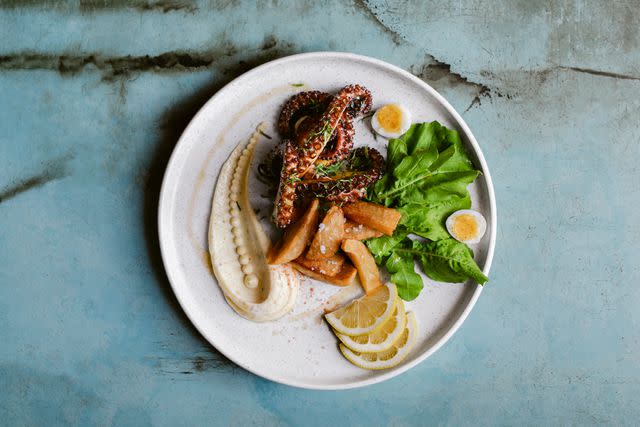
Marta Tucci
Octopus with spicy potatoes, quail egg, and aioli at Jacaré do Brasil.While the Fasano’s opening was not without controversy — Das, in particular, was skeptical about the impact of development on the beach — the construction of any more hotels or resorts is unlikely given the difficulty of pulling off megaprojects in this remote stretch of Bahia. “Nobody would dare build inland because the infrastructure, dictated by a single road, is a disaster,” Das said.
As we sat together on the Quadrado, sheltered by a giant almond tree, Das was guardedly optimistic about the future. “When I first came, they thought I was going to put a Diesel shop on the Quadrado,” he said. “Trancoso has always been forgotten, which is why it’s survived so well.”
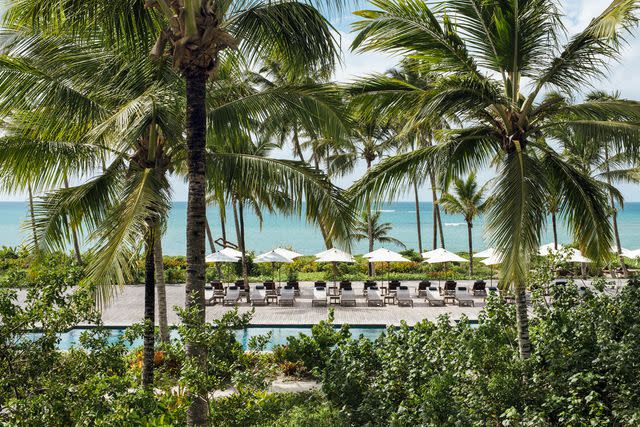
Marta Tucci
A swimming pool at Hotel Fasano Trancoso, which fronts Itapororoca Beach.Trancoso Tip Sheet
Where to Stay
Hotel Fasano Trancoso
This sleek newcomer, designed by Brazilian celebrity architect Isay Weinfeld, occupies a prime spot on pristine Itapororoca Beach. Its 40 bungalows sit amid swaying palms, though most guests will opt to hang out by the Olympic-size swimming pool that runs parallel to the ocean.
The original Trancoso HQ for the boho set, the 24-room Uxua, which opened in 2009, still impresses with its historic renovated casas that line the Quadrado in fuchsia, peppermint green, and other candy colors. The restaurant is one of the best in Trancoso. Uxua Praia, the hotel’s beach club and bar, is an easy eight-minute stroll.
Where to Eat
A Creperia
Among the several casual food stands along the Quadrado, A Creperia is one of the most popular—especially for its sweet options, like the chocolate crêpes with house-made passion-fruit ice cream and Nutella with fresh strawberries.
The main reason to visit this hotel is the food: chef Sandra Marques creates some of the finest Bahian dishes in town, with a focus on seafood (the ceviche, grilled shrimp, and steamed catch of the day with house-made chili oil are standouts). The setting—an open- air dining room shrouded in palm fronds off the Quadrado—is quintessential Trancoso.
Dining at this design showroom-slash-restaurant is as much an aesthetic experience as a gustatory one. Have an Italian-inflected dinner of lobster risotto or shiitake-mushroom tortellini, or pull up a bright-pink stool at the bar for a perfect caipirinha.
How to Book
Rio de Janeiro–based T+L A-List travel advisor Paul Irvine (paul.irvine@dehouche.com) and his team can make the long journey to Trancoso easier, with smooth on-the-ground transfers and fun layover itineraries in São Paulo. Irvine can also organize activities like jungle ATV rides and fishing excursions that take full advantage of the Bahian wilderness.
A version of this story first appeared in the September 2023 issue of Travel + Leisure under the headline "The Boho Zone."
For more Travel & Leisure news, make sure to sign up for our newsletter!
Read the original article on Travel & Leisure.

